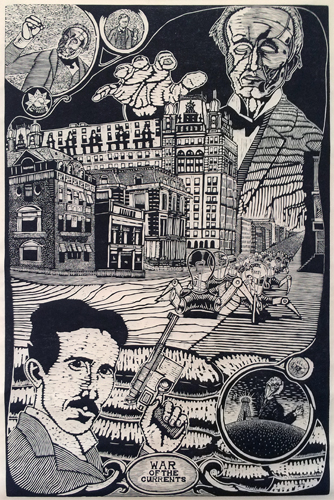Bradley Taylor

War of the Currents
In the late 1880"s a war was waging between the old school and the new school of electro-engineering. Patent hound Thomas Edison had a monopoly on energy distribution in the states and aimed to keep it that way. Much to his dismay American entrepreneur and mustache enthusiast George Westinghouse was conspiring to bring alternating current to the mainstream in order to fell Edison's mighty Empire.
At the heart of the Edison dynasty was direct current. Also known as DC, direct current is energy fed directly to a consumer load via generator. DC could not travel long distances, which meant consumers had to be near a generator for reliable energy. This could get expensive especially for rural areas. DC's voltage was also very difficult to convert, more demanding customer needs required different generators that would require frequent maintenance. But Edison was not worried, it was all part of Edison's dastardly plan. Ever since he invented the light bulb Edison longed to create a cumbersome less than efficient system for feeding his light bulbs, which in turn would feed his favorite invention the meter.
Westinghouse on the other hand believed in the potential of alternating current also known as AC. Alternating current relies on transformers that convert high voltage to low voltage. Because it can travel at higher voltage AC current can cover greater distances and requires fewer plants and less maintenance. Westinghouse seemed to have all the makings to be a real contender except for one. He needed a Hero.
Little did Westinghouse know that his hero was working for Edison. Enter Nikola Tesla. The young Austrian born engineer had been working for Edison since 1882 in Paris and had just moved to New York, to work with Edison's Edison Machine Works. It wasn't long before Tesla began to feel underappreciated. When asked about Tesla, Edison would claim that Tesla's ideas were fascinating but impractical; and at annual company soft ball game it seemed as though Tesla was always among the last picked. The final straw came when Edison promised Tesla $50,000 if he could redesign Edison's inefficient motor and generator. After Tesla completed his task and when he went to collect his fee Edison mocked him and told him that he didn't understand American humor. Laughing, Edison drove off in his Firebird splashing Tesla as he went by. Soon after a Limousine pulled up and a hand wearing a white glove invited Tesla into the car. Inside the limo was Westinghouse eager to form an alliance with this brilliant young street tough. Spitefully driven Tesla and Westinghouse's money were a dynamic duo and after seeing Tesla's AC Polyphase system the world was convinced.
Angry and defeated Edison slithered back to his lair and called on his minions to begin an active campaign against AC current. He ordered them to go into the streets and collect all the stray cats, and dogs; and any unwanted livestock. After the animals were collected Edison ordered for them to be publically executed to demonstrate the dangers of AC current. After the grizzly tasks was carried out Edison asked his henchman to construct a special chair he had designed known as the "electric chair" that was designed to kill a man with AC current. His men began work on the chair while Edison worked on a top-secret project.
Soon it came time to use the chair, Edison had used his political connections to the chair used on a man who murdered his wife with a hatchet. Little did any of the town's people know what Edison had in store. For shortly after the turbulent execution something strange was spotted in downtown New York. It was a mechanical replica of Thomas Edison several stories tall. The massive mechanical man was blazing a trail through the crowed city, toppling buildings, crushing cars and making people late for their appointments. Survivors from tall buildings reported that the giant Edison appeared to be holding the crushed original inventor.
The colossus continued it's path of destruction until it reach the Waldorf Astoria where Tesla, armed only with his SG29 pistol and dashing good looks was waiting behind his bunker. Tesla fired two carefully aimed shots hitting the electric man on his temple then his jaw. The colossus turned Tesla's direction and then released millions of spider legged light bulbs. Tesla began firing wildly at the metal multitude flowing toward him. Confetti of bullets and glass littered the streets as tesla coolly to out one after other. Soon it became clear that Tesla's ammunition did not match the numbers in the sea of bulb-bots, so Tesla used his powers to mentally commune with the pigeons.
Birds began swooping in from all around picking up and dropping the bulb-bots. With the pigeons help Tesla saw his opportunity to lead the Giant into a trap. Using himself as bait Tesla led the mechanize terror back to the Wardenclyffe Tower. Tesla quickly entered the facility and run to the access panel to turn the mighty transmitter on. Just then the claws of the beast came down and tore the roof from the rafters. A loose piece of debris swung down narrowly missing Tesla's face and badly damaging a crucial copper wire connection. For a moment Tesla feels panic as he looks at the broken connection, the mighty hand is baring down on him once again. In a last ditch effort Tesla throws his SG29 into the frayed wires and completes the current. The tower sends out a huge burst of energy, which brought the giant down.
Later the City of New York held a special ceremony to commemorate what Tesla had done. At the end of the gathering, using cranes, the citizens of New York place the evil giant's remains on a specially designed remote control boat Tesla had cooked up. The boat sailed unmanned out to the middle of the Atlantic and dumped the remains, and there they rest to this day.